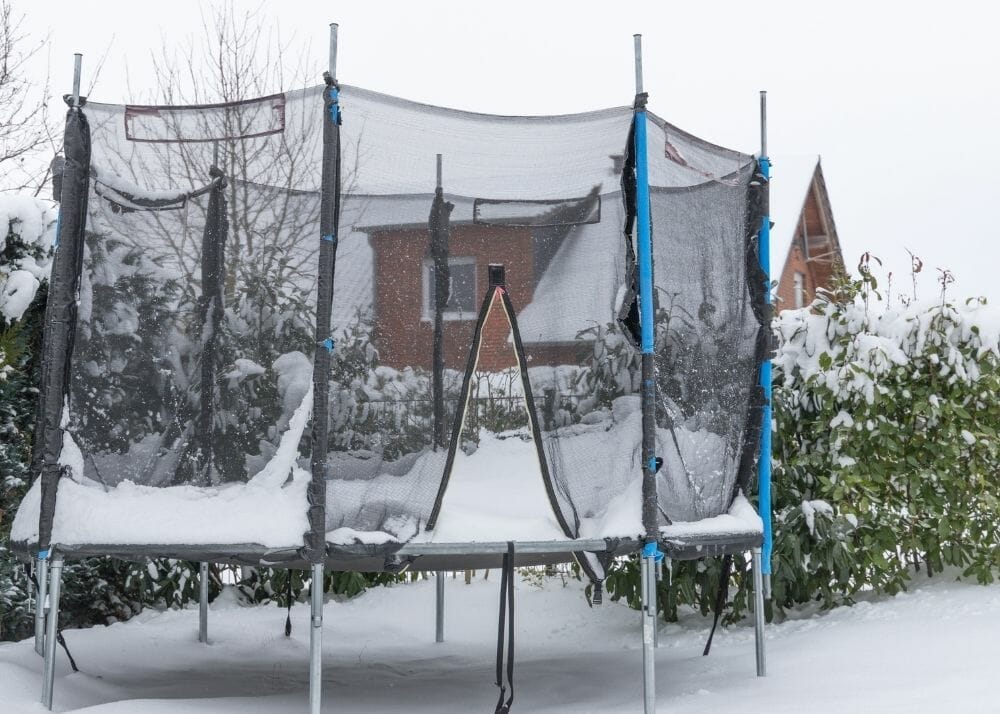Everyone may enjoy jumping on the trampoline together when the weather is nice. But what about when it gets cold, and everyone stays inside? Then, it may be left unprotected in the backyard, where it will be subjected to elements, including wind, rain, and snowfall.
It might be harmed or destroyed by the weather. Let’s learn how to winterize your trampoline in 3 different ways with us. It’s far more straightforward than you may imagine. And you’ll end up saving a lot of money. Okay, so let’s dive in.
What is Winterization?
Preparing your house or garden for the winter is known as “winterizing.”
While you may be more familiar with the concept of “winterizing” in the pool or an automobile, you should know that playground equipment also needs attention when the weather turns cold. That’s why it’s essential to take the time to winterize your trampoline before the temperature drops.
As a bonus, your trampoline will be entirely ready for use as soon as the sun heats up again. Read on for three tried-and-true methods of keeping your trampoline in tip-top shape during the colder months.
How To Winterize A Trampoline? 3 Effective Ways
1. Ground It
Trampolines are typically constructed with sufficient weight to prevent them from moving. However, if they are incredibly small or situated in a vulnerable region, they may be blown about or carried out during a storm.
A trampoline can be blown away and land on somebody else’s property due to the wind friction caused by the trampoline’s bottom and the sail-like effect of the net.
This is dangerous since it may destroy material, cause injuries, and harm your trampoline. The most accessible approach to prevent this is to use tie-down equipment to secure the trampoline to the ground. You may purchase them with your trampoline, but they are also available alone.
Belts and anchors are provided so the trampoline may be secured to the ground. Sizes vary to accommodate varying wind speeds and conditions.
Ties are an excellent method of keeping your trampoline in place. However, heavy precipitation might weaken the ground and cause the anchors to pull out. Maintaining a periodic inspection schedule can help you prevent the danger of a trampoline escaping from its attachments.
There may be issues with securely anchoring your trampoline to the ground if your ground is sandy. The usage of sandbags is a viable option in this scenario. The trampoline will only stay in place if you provide adequate weight.
It’s probably best to keep the trampoline inside a garage during a windstorm if you prefer not to use pegs or if you reside in a very stormy location.
Related: Best InGround Trampolines for 2023
2. Use a Cover to Winterize Trampoline
Covering your trampoline is just as essential as anchoring it to the ground.
It prevents dirt and humidity from adhering to the surface. To suit the bouncing mat, certain coverings need the cushions and netting to be removed. Keep them in a clean, dry environment once you’ve given them a good cleaning.
You should choose a cover that accommodates your trampoline firmly and tightly to preserve it from the weather. Numerous designs will have a drain to prevent water from pooling on the ground and causing damage.
When significant snowfalls occur, it’s essential to frequently remove the snow by sweeping it away with a paintbrush or shovel. In addition, having snow on your trampoline might cause the springs to extend too much, reducing the rebound quality.
There are bigger coverings available that may offer total security without the need to replace the cushions and netting. The jumping mats won’t break, and your gear won’t get dirty from bird waste or dirt.
However, they are pricey, far more than regular covers. They also help reduce the amount of moisture that might damage your trampoline’s springs and reduce its aesthetic appeal and overall effectiveness.
3. Detach and Put Away
Consider dismantling your trampoline if you want to store it in a carport or basement. Then, you won’t have to worry about keeping it anchored and covered or clearing away snow and twigs.
The handbook that came with your trampoline should provide directions on how to take it apart. Keep the trampoline neat and dry when putting it away. This will stop any fungus or mould from taking hold.
Disassembling the trampoline may be a hassle, but storing it away for the winter ensures it will be safe from dust, rain, and snow. Putting up and taking down your trampoline will become second nature after the first few times you perform it each year.
However, if you have access to a spacious parking or warehouse place, you may keep the trampoline there without taking it apart. Instead, protect it from dirt and insects by covering it with a tent or tablecloth.
You also might be interested in: How to Take Down a Trampoline in 7 Easy Steps
Is It Safe to Put a Trampoline Outside During the Winter?
If you live in an area prone to severe weather events or plan to be away from home for an extended period, consider taking precautions to safeguard your trampoline.
There are trampolines without springs available if you live in an area with harsh winters and don’t like to wrap or preserve your trampoline. Their heavy gauge construction, rust-free poles, and UV-resistant matting guarantee they will retain their lustre as soon as some other trampolines.
Conclusion
The above easy ways will keep your trampoline tidy, secure, and undamaged over the cold season. However, the time spent on these precautions is little compared to the expense of fixing or renewing your trampoline or compensating for repairs if it smashes through a neighbour’s house or gets damaged in cold. Let us know in the comments section which method you will be using for winterizing your trampoline.




1 thought on “How To Winterize A Trampoline in 3 Effective Ways”